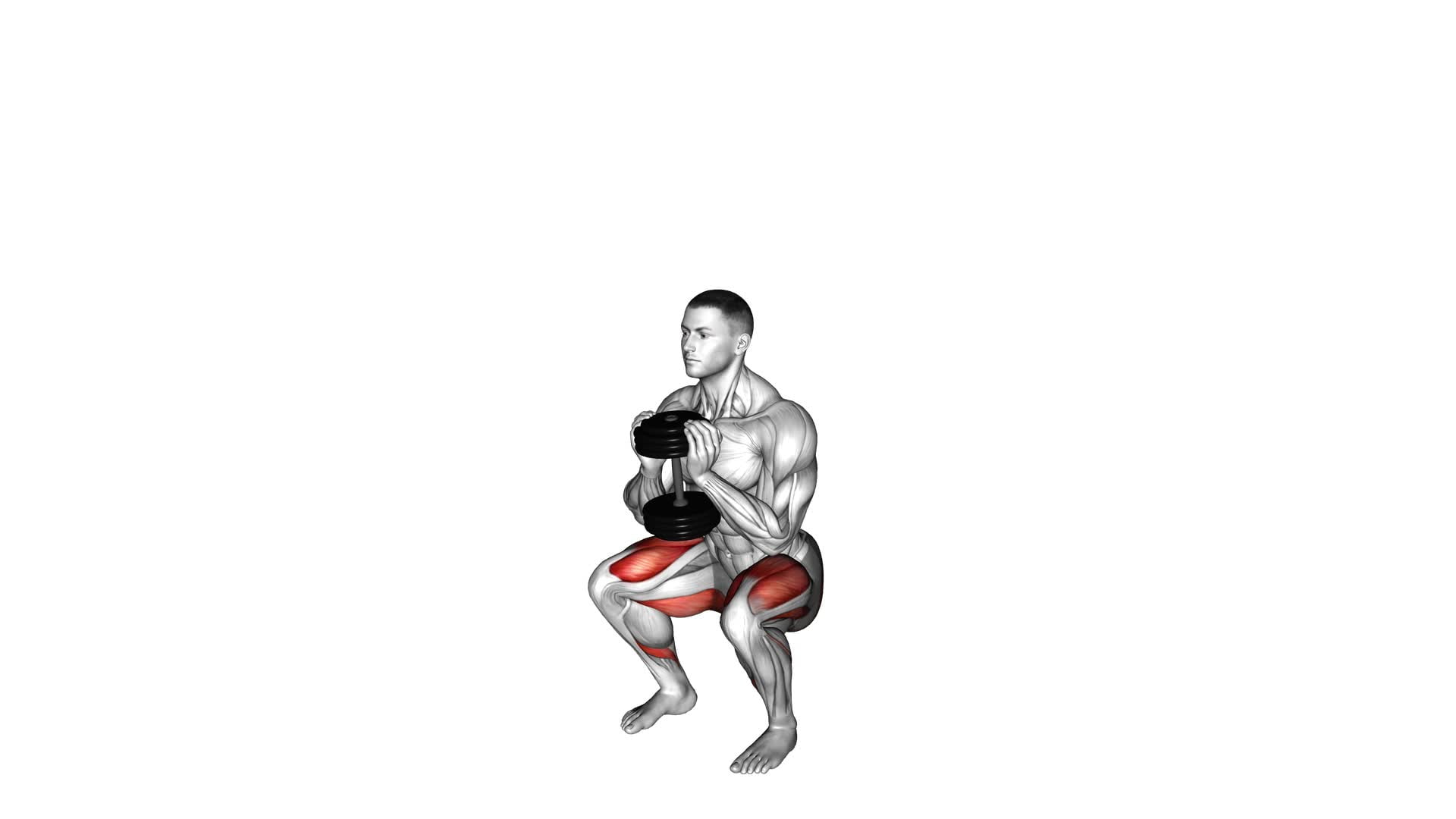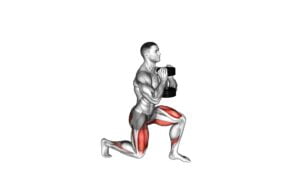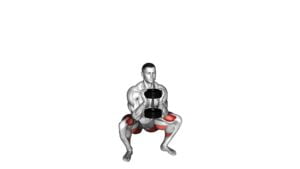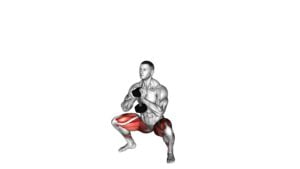Dumbbell Goblet Squat – Video Exercise Guide & Tips

Are you looking to level up your squat game?
Watch This Exercise Video
Then the dumbbell goblet squat is the exercise for you!
This video exercise guide and tips will show you how to properly perform this effective lower body movement.
By using a second person point of view, active voice, and contractions, we'll guide you through the benefits, proper form, variations, and common mistakes to avoid.
Get ready to challenge yourself and achieve those squat goals!
Key Takeaways
- The Dumbbell Goblet Squat maximizes gains in a workout routine.
- It activates major muscle groups such as quadriceps, hamstrings, and glutes.
- Engaging core muscles, including abdominals and lower back, is an important aspect of this exercise.
- The Dumbbell Goblet Squat improves squat performance, stability, and balance while enhancing overall fitness and performance.
Benefits of the Dumbbell Goblet Squat
You can maximize your gains by incorporating the dumbbell goblet squat into your workout routine. This exercise offers numerous benefits, including muscle activation and increased core strength.
The dumbbell goblet squat targets several major muscle groups, such as the quadriceps, hamstrings, and glutes. As you lower into the squat position, these muscles are activated to support the movement and provide stability.
Additionally, the dumbbell goblet squat engages your core muscles, including the abdominals and lower back, to maintain proper posture throughout the exercise. This increased core strength not only improves your squat performance but also enhances your overall stability and balance.
By incorporating the dumbbell goblet squat into your routine, you'll experience improved muscle activation and increased core strength, leading to better overall fitness and performance.
Now, let's move on to the next section to learn about the proper form and technique for executing this exercise effectively.
Proper Form and Technique
To perform the dumbbell goblet squat with proper form and technique, start by holding an appropriate weight dumbbell in front of your chest. Stand with your feet shoulder-width apart and toes pointed slightly outward. Keep your core engaged and your chest lifted throughout the exercise.
As you begin the squat, lower your body by bending at the knees and hips, as if you're sitting back into a chair. Keep your weight in your heels and your knees in line with your toes. Lower until your thighs are parallel to the ground or as low as your flexibility allows.
Common errors to avoid during the dumbbell goblet squat include rounding your back, leaning too far forward, or allowing your knees to collapse inward. These mistakes can put unnecessary strain on your lower back and knees.
If you're looking to challenge yourself and take the dumbbell goblet squat to the next level, you can try some advanced modifications. One option is to increase the weight of the dumbbell to add more resistance. Another option is to perform the squat on an unstable surface, such as a BOSU ball or a balance disc, to engage your core and improve stability.
Now that you have mastered the proper form and technique of the dumbbell goblet squat, let's explore some variations to challenge yourself even further.
Variations to Challenge Yourself
To further challenge yourself, consider incorporating variations of the dumbbell goblet squat. By adding these advanced goblet squat techniques to your workout routine, you can target different muscle groups and increase the intensity of your training. Here are four dumbbell squat variations that can help you take your goblet squats to the next level:
- Bulgarian Split Squat: Place one foot on an elevated surface behind you while holding the dumbbell in the goblet position. This variation increases the demand on your quads, glutes, and core, providing a greater challenge to your lower body.
- Sumo Squat: Take a wider stance with your feet turned out at an angle. Hold the dumbbell in front of your chest and perform squats. This variation primarily targets your inner thighs and glutes, helping to improve hip mobility and strength.
- Single-Leg Goblet Squat: Stand on one leg while holding the dumbbell in the goblet position. Bend your standing leg and lower your body into a squat position. This variation enhances balance, stability, and unilateral leg strength.
- Goblet Squat Jump: Hold the dumbbell in the goblet position and perform a squat. As you come up, explode off the ground and jump as high as possible. This plyometric variation helps improve power and explosiveness in your lower body.
Incorporating these dumbbell squat variations into your routine can provide a fresh challenge and help you continue to progress in your fitness journey. Remember to start with lighter weights and focus on mastering the proper form before increasing the intensity.
Tips for Beginners
For beginners, it's important to start with lighter weights and focus on mastering the proper form before increasing the intensity of your dumbbell goblet squats. This exercise may seem simple, but there are a few common misconceptions that you need to be aware of.
One misconception is that using heavier weights will lead to faster results. However, using weights that are too heavy can compromise your form and increase the risk of injury. It's better to start with lighter weights and gradually increase the load as you become more comfortable and confident with the exercise.
Another misconception is that this exercise is only for advanced fitness levels. The truth is, the dumbbell goblet squat can be modified to suit different fitness levels. If you're a beginner, you can start by using just your body weight or lighter dumbbells. As you progress, you can gradually increase the weight to challenge yourself further. Remember to always listen to your body and only increase the weight when you feel ready.
Now that you know some tips for beginners, let's move on to the next section and discuss some common mistakes to avoid when performing the dumbbell goblet squat.
Common Mistakes to Avoid
Avoid these common mistakes when performing the dumbbell goblet squat to ensure proper form and reduce the risk of injury:
- Incorrect posture: One of the most common mistakes is having poor posture during the exercise. Make sure to keep your chest up, shoulders back, and core engaged throughout the movement. This will help maintain proper alignment and prevent unnecessary strain on your lower back.
- Knees collapsing inward: Another mistake to avoid is letting your knees cave inwards as you squat. This puts excessive stress on your knee joints and can lead to injury. Instead, focus on pushing your knees outwards, in line with your toes, to maintain proper alignment.
- Lifting too heavy: It's important to start with an appropriate weight that allows you to maintain proper form. Lifting too heavy can compromise your technique and increase the risk of injury. Gradually increase the weight as you become more comfortable and confident with the exercise.
- Not going low enough: A common mistake isn't squatting low enough, which limits the effectiveness of the exercise. Aim to lower your hips until your thighs are parallel to the ground, or even slightly below if you have the flexibility. This will engage your glutes and quads more effectively.
By avoiding these common mistakes and focusing on proper execution, you can maximize the benefits of the dumbbell goblet squat while minimizing the risk of injury.
Remember to always listen to your body and consult with a fitness professional if you have any concerns or questions.
Frequently Asked Questions
How Many Sets and Reps Should I Do for the Dumbbell Goblet Squat?
To determine the number of sets and reps for the dumbbell goblet squat, you need to consider your fitness level and goals. Generally, beginners can start with 2-3 sets of 8-12 reps.
As you progress, you can increase the sets and reps to challenge your muscles. Remember, it's important to listen to your body and gradually increase the intensity.
There are also variations and progressions that you can incorporate to keep challenging yourself.
Can I Use a Kettlebell Instead of a Dumbbell for the Goblet Squat?
Yes, you can definitely use a kettlebell instead of a dumbbell for the goblet squat. Using a kettlebell offers its own unique benefits, such as increased grip strength and core engagement.
It's a great way to add variation to your goblet squat routine and challenge your muscles in a different way. Just make sure to maintain proper form and technique to ensure maximum effectiveness and prevent injuries.
Is the Dumbbell Goblet Squat Suitable for People With Knee or Back Problems?
If you have knee or back problems, it's important to consult with a healthcare professional before attempting the dumbbell goblet squat.
While this exercise can be beneficial for strength training, modifications may be necessary to accommodate any limitations or discomfort you may have.
It's always best to prioritize your safety and tailor your workout routine to suit your specific needs.
Should I Do the Dumbbell Goblet Squat Before or After My Cardio Workout?
Before or after your cardio workout, doing the dumbbell goblet squat can provide you with various benefits.
This exercise targets your lower body muscles, including your quads, glutes, and hamstrings.
By incorporating it into your routine, you can enhance your strength and stability.
Additionally, the dumbbell goblet squat offers different variations, allowing you to tailor it to your fitness level and goals.
Consider adding it to your workout regimen to maximize your gains and improve your overall fitness.
Can I Incorporate the Dumbbell Goblet Squat Into a Full-Body Workout Routine?
Incorporating the dumbbell goblet squat into your full-body workout routine can be a great idea.
This exercise targets multiple muscle groups, including your legs, glutes, and core.
You can also try different variations of the dumbbell goblet squat to challenge yourself and keep your workouts interesting.
Adding this exercise to your routine will help improve your overall strength and stability, making it a valuable addition to a well-rounded workout program.
Conclusion
In conclusion, the dumbbell goblet squat is a highly effective exercise that targets multiple muscle groups and offers a range of benefits.
By maintaining proper form and technique, you can maximize the results of this exercise and minimize the risk of injury.
Additionally, incorporating variations and challenging yourself can help to further enhance your strength and endurance.
Remember to start with lighter weights if you're a beginner and avoid common mistakes such as rounding your back.
With practice and consistency, you can reap the rewards of this powerful exercise.

Author
Years ago, the spark of my life’s passion ignited in my mind the moment I stepped into the local gym for the first time. The inaugural bead of perspiration, the initial endeavor, the very first surge of endorphins, and a sense of pride that washed over me post-workout marked the beginning of my deep-seated interest in strength sports, fitness, and sports nutrition. This very curiosity blossomed rapidly into a profound fascination, propelling me to earn a Master’s degree in Physical Education from the Academy of Physical Education in Krakow, followed by a Sports Manager diploma from the Jagiellonian University. My journey of growth led me to gain more specialized qualifications, such as being a certified personal trainer with a focus on sports dietetics, a lifeguard, and an instructor for wellness and corrective gymnastics. Theoretical knowledge paired seamlessly with practical experience, reinforcing my belief that the transformation of individuals under my guidance was also a reflection of my personal growth. This belief holds true even today. Each day, I strive to push the boundaries and explore new realms. These realms gently elevate me to greater heights. The unique combination of passion for my field and the continuous quest for growth fuels my drive to break new ground.



